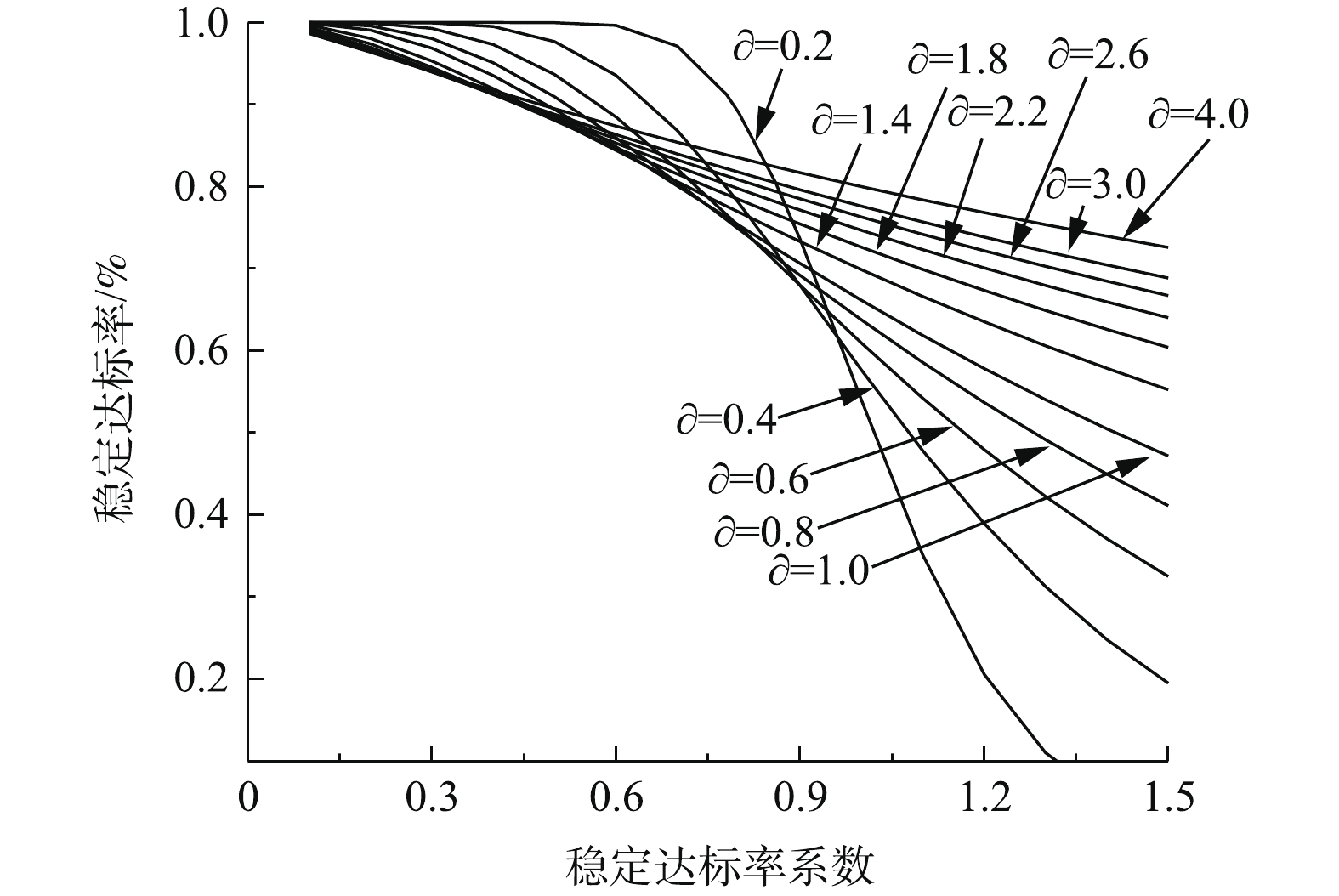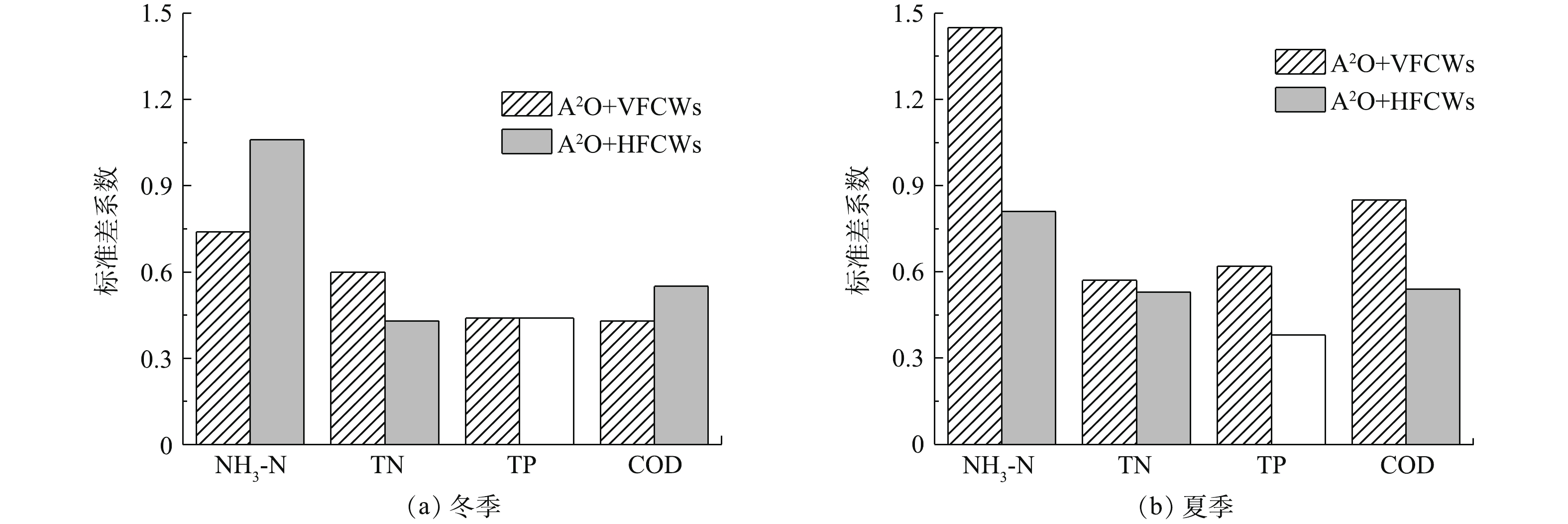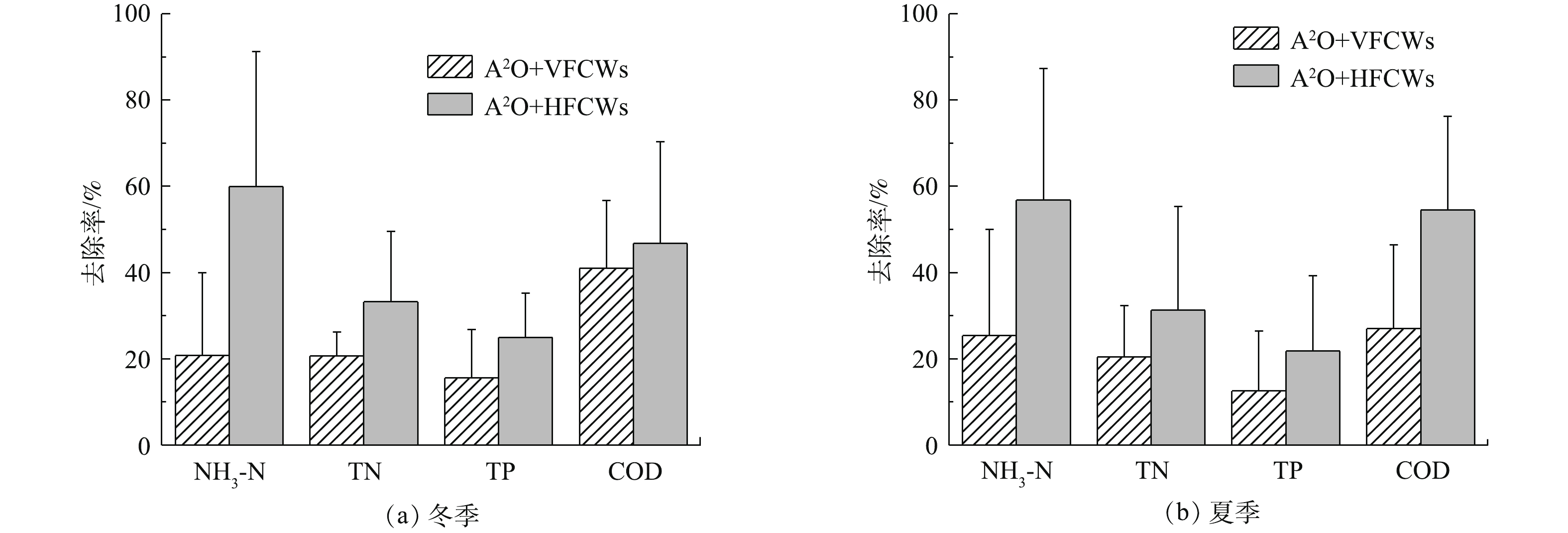-
人工湿地对污水中的氮、磷污染物有很好的去除效果,而且具有投资成本低、维护管理方便和不产生二次污染等优点[1],在农村生活污水处理领域具有广阔的应用前景。目前,人工湿地在农村生活污水中的应用以潜流式为主,包括水平流人工湿地(horizontal flow constructed wetland,HFCWs)和垂直流人工湿地(vertical flow constructed wetland,VFCWs),设计时通常参考国家环保部发布的《人工湿地污水处理工程技术规范》(HJ 2005—2010)。该规范主要适用于城镇污水厂出水深度处理,HFCWs与VFCWs水力负荷建议取值为0.015~0.5 m3∙(m2∙d)−1和0.2~0.8 m3∙(m2∙d)−1;针对农村水质水量变化大、地区之间差别大的情况,参数取值的适宜性尚需探讨。
长三角平原地区人口密度高、环境负荷大、土地资源紧缺,且位于太湖流域,环境敏感性高,近年来对农村生活污水治理与达标排放的要求越来越严格,处理工艺也因此由最初的单纯厌氧池或单纯人工湿地系统慢慢演变为生物处理+人工湿地组合工艺。在生物处理+人工湿地组合工艺中,生物处理被认为担任去除有机污染物、悬浮物和脱氮除磷的主要角色,普遍采用在市政污水处理效果较好的A2O (anaerobic-anoxic-oxic)工艺。污水经生物处理后,可降低后续人工湿地单元的进水浓度,在进一步去除氮磷、稳定出水水质的同时,减少湿地的占地面积[2]。农村生活污水的水量和水质受季节、时段的影响变化大[3],设施进水碳氮比低、运行过程中溶解氧控制调整难[4-7],这些因素均将增加A2O和人工湿地在处理农村生活污水中充分硝化和高效脱氮除磷方面的难度,从而影响设施效果的发挥。
本研究以嘉兴海宁的农村生活污水处理设施为研究对象,实地抽检了11个乡镇内28座A2O与VFCWs组合工艺(A2O+VFCWs)设施和46座A2O与HFCWs组合工艺(A2O+HFCWs)设施,运用统计学方法比较了2种组合工艺处理农村生活污水的出水稳定性及稳定达标率,分析了A2O单元和人工湿地单元对污染物去除的各自贡献率,剖析了2种组合工艺的设计与运行问题,旨在为组合工艺今后脱氮除磷的性能提升提供参考。
全文HTML
-
在海宁市11个乡镇随机选取74座A2O与人工湿地组合工艺设施,开展现场调研和水质检测(表1),其中冬季和夏季各抽检A2O+VFCWs设施8和21座,A2O+HFCWs设施16和29座,设计处理规模覆盖10~80 t∙d−1。冬季交予第3方运维企业的设施数量为504座,其中,30 t∙d−1以下(包含30 t∙d−1)为401座,超过30 t∙d−1设施数量为103座,夏季交予3方运维企业的设施数量增多,达到了796座,其中30 t∙d−1以下(包含30 t∙d−1)为604座,超过30 t∙d−1设施数量为192座。2个季度调研选取比例均是按照地区处理规模30 t∙d−1以下(包含30 t∙d−1)按5%的比例随机抽取,超过30 t∙d−1按照10%随机抽取。2种组合类型工艺流程如图1所示。
A2O单元的厌氧池、缺氧池和好氧池中均填充弹性填料,填充率为55%~70%,好氧池后设有二沉池,二沉池的污泥液通过气提泵回流至厌氧池,排泥较少。A2O+HFCWs的A2O单元有效容积随设计处理规模变化而变化,水力停留时间约为24 h;A2O+VFCWs的A2O单元不论设计规模,池容积固定为12 m³,水力停留时间为3.6~14.4 h。2种组合工艺前端A2O池内曝气均采用涡漩风机,设计规模为30 t∙d−1以下的处理设施,曝气量为0.225 m3∙min−1;设计规模为50 t∙d−1的处理设施,曝气量为0.59 m3∙min−1;设计规模为80 t∙d−1的处理设施,曝气量为0.67 m3∙min−1。
2种类型湿地设计深度为1.2 m,底部均有防渗膜(两布一膜)做防渗处理,以地面为参考面,HFCWs和VFCWs出水口高度为−0.2 m和−0.9 m,HFCWs和VFCWs设计水力负荷分别约为0.93 m3∙(m2∙d)−1和0.36 m3∙(m2∙d)−1,在相同处理规模情况下的HFCWs面积比VFCWs小,水力停留时间短。HFCWs填料类型为轻质页岩陶粒,VFCWs填料类型为砂石颗粒,粒径在1~3 cm。湿地植物包括美人蕉(Canna indica)、菖蒲(Acorus calamus L)、旱伞草(Phyllostachys heteroclada Oliver)、花叶芦竹(Arundo donax)、芦苇(Phragmites australis)和香蒲(Typha orientalis Presl)等挺水植物,按密度9~25 株∙m−2种植,生长情况良好,无死苗、缺苗情况。
-
采样区域目前执行农村生活污水污染物排放地方标准,具体如下:化学需氧量(chemical oxygen demand, COD)≤100 mg∙L−1、氨氮(ammonia nitrogen, NH3-N)≤25 mg∙L−1、悬浮物(suspended solids, SS)≤30 mg∙L−1、总磷(total phosphorus, TP)≤3 mg∙L−1,未对出水总氮(total nitrogen, TN)进行要求。但是预计不久的将来,会对一部分排入敏感水体的设施提升排放要求,根据修订标准的征求意见稿,预计的标准修订为COD≤60 mg∙L−1、NH3-N≤15 mg∙L−1、SS≤20 mg∙L−1、TP≤2 mg∙L−1、TN≤20 mg∙L−1。
-
调研区域每个站点取样数量为3个,未设置平行样,但在每批水质测试时设置质控样;冬季采样日期为2018年12月,日均气温6 ℃,采样期间存在持续性降雨;夏季采样时间为2019年5月末至7月,日均气温为28 ℃,采样前3 d无降雨。冬季和夏季每个处理设施均依次从集水井、A2O的二沉池和出水井采集3瓶水样于550 mL塑料瓶中密封保存,分别作为A2O单元的进水、A2O单元的出水(亦即湿地单元进水)、以及湿地出水。测试指标为COD、NH3-N、TN、TP、SS,按国标方法[8]进行,试剂无特别说明均为分析纯。水样采集后立即放置于4 ℃冷藏保存,NH3-N和TN在24 h内、TP在48 h内、COD和SS在72 h内完成分析测试。
-
1)出水水质稳定性分析采用标准差系数法(
Vσ ),显示处理设施出水各污染指标浓度在中心位置处的集中程度,计算方法如式(1)所示。式中:X为各水质指标平均值;Xi为各水质指标监测值;N为样本数量。
2)出水稳定达标率分析采用偏差系数法和NIKU等[9]开发的模型计算。偏差系数(β),指出水水质各污染指标浓度与规定排放标准浓度的偏离程度,指示判断出水浓度是否集中在小于或大于规定排放标准值的方向上。计算方法如式(2)所示。
式中:β为偏差系数;Xs为排放标准值浓度,mg∙L−1。
在NIKU等[9]开发的模型计算法中,稳定达标率是指在一定的样本数量中出水浓度符合排放标准浓度的样本数量百分比,计算方法如式(3)所示。
式中:mx为平均出水浓度,mg∙L−1;ϕ为稳定达标系数,是指达到设计出水标准的系数;稳定达标系数可用式(4)计算得到。
式中:
∂ 为变异系数,是标准偏差与平均出水浓度的比值;α为不符合排放标准的概率,1−α为符合排放标准的概率;Z1−α为标准正态变量,可由式(5)计算得到,可根据Z1−α值得到稳定达标率。不同稳定达标系数和不同变异系数下出水浓度达标概率如图2所示。冬季和夏季2种组合类型的A2O和人工湿地对NH3-N、TN、TP和COD平均去除率,采用单因素方差方法进行差异显著性分析,分析软件为Excel 2019。
1.1. 研究对象概况
1.2. 排放标准
1.3. 水样采集与分析测试
1.4. 数据统计分析
-
1)出水稳定性。2种组合工艺在冬季和夏季的出水标准差系数如图3所示。有研究[10-11]表明,标准差系数Vσ≤0.5是正常波动范围,0.5<Vσ≤1.0是可接受的波动范围,Vσ>1.0则认定为异常波动。在冬季,A2O+VFCWs出水标准差系数分别为NH3-N(0.74)、TN(0.60)、TP(0.44)和COD(0.43),而A2O+HFCWs出水标准差系数则相应为NH3-N(1.06)、TN(0.43)、TP(0.44)和COD(0.55)。与A2O+HFCWs相比,A2O+VFCWs出水稳定性明显较好,特别是NH3-N和COD,浓度标准差系数分别低了0.32和0.12。
在夏季,A2O+VFCWs出水标准差系数分别为NH3-N(1.45)、TN(0.57)、TP(0.62)和COD(0.81),而A2O+HFCWs出水标准差系数分别为NH3-N(0.81)、TN(0.53)、TP(0.38)和COD(0.54)。A2O+HFCWs出水的各指标标准差系数在夏季与冬季相差不大,甚至比冬季略有改善;而A2O+VFCWs出水的各指标标准差系数在夏季则普遍大幅度升高,显示出水水质的稳定性变差。将2种组合工艺进行比较,则发现夏季A2O+VFCWs出水各指标的标准差系数均比A2O+HFCWs大,出水稳定性较差。
2)出水稳定达标率和偏差系数。2种组合工艺的稳定达标率和偏差系数如表2所示。利用NIKUS模型进行分析发现在冬季2种组合工艺的出水稳定达标率相差不大,其中NH3-N和COD的稳定达标率接近100%,TP与SS的稳定达标率在90%以上。由于该地区雨污分流不彻底,降雨时雨水通过管网汇入,稀释了进水浓度,此外,部分雨水又通过人工湿地表面进入2级处理单元,降低了出水浓度,在两者的共同作用下,导致出水浓度降低,从而间接提高了设施冬季稳定达标率。在夏季,A2O+VFCWs出水NH3-N、TP、COD和SS稳定达标率比冬季略有下降,分别为89.8%、44.5%、98.1%和85.3%,比A2O+HFCWs高出22.7%、12.2%、5.0%和27.2%。进一步用偏差系数法分析发现在冬季2种组合工艺的出水偏差系数均小于0,这说明其出水浓度集中小于规定浓度排放值,出水稳定达标率较高;在夏季,A2O+HFCWs出水NH3-N、TP、SS与A2O+VFCWs出水TP偏差系数均大于0,2种组合工艺对部分污染物的稳定达标率较低。
无论是使用NIKUS模型法还是偏差系数法,均表明A2O+VFCWs的稳定达标率高于A2O+HFCWs。在冬季,2种组合工艺的稳定达标率均较高,差别不大;在夏季,A2O+VFCWs的出水TP稳定达标率变差,A2O+HFCWs则是出水NH3-N、TP和SS稳定达标率均变差。夏季出水稳定性下降,这一结论与环境工程学和人工湿地科学研究不一致,通过现场调查发现,该地区农村普遍存在雨污分流不彻底情况,夏季存在强降雨过程,瞬时冲击负荷过大,导致污泥流失,从而影响设施的处理效果。
-
A2O与人工湿地对各污染物去除贡献率占比如图4所示。对整个工艺去除效果进行分析,发现A2O+VFCWs组合工艺对COD、NH3-N、TN和TP的平均去除率,在冬季为(82.0±18.5)%、(94.8±8.8)%、(49.3±16.8)%和(50.9±16.8)%,在夏季为(72.5±13.2)%、(80.0±16.9)%、(30.0±17.8)%和(30.7±18.9)%,对污染物去除起主要作用的单元是VFCWs;而对于A2O+HFCWs组合工艺,对COD、NH3-N、TN和TP的平均去除率在冬季为(59.3±21.4)%、(79.1±19.9)%、(42.3±17.3)%和(25.0±10.2)%,在夏季为(62.2±18.0)%、(58.1±30.8)%、(40.6±20.0)%和(28.9±15.7)%,对污染物去除起主要作用的单元是A2O。在A2O+VFCWs工艺中,各污染物主要由VFCWs去除,贡献率为51%~95%。而在A2O+HFCWs工艺中,对NH3-N、TN和COD起主要作用的为A2O,贡献率为53%~80%。
1) A2O去除效果及问题分析。2种组合工艺的A2O单元对各污染物去除率如图5所示。对调研处理设施的A2O单元各污染物平均去除率做单因素方差分析,发现无论在冬季还是夏季,NH3-N去除效果差异显著(P<0.01);而TN差异不显著(P>0.05);TP冬季差异显著(P<0.01),夏季则差异显著(0.01<P<0.05);COD冬季差异不显著(P>0.05),夏季差异显著(P<0.01)。A2O+HFCWs中的A2O单元对NH3-N、TN、TP和COD的去除率在冬季为(59.9±31.3)%、(33.6±16.3)%、(25.0±10.2)%和(46.8±23.6)%,在夏季为(56.8±30.4)%、(31.3±24.1)%、(21.8±17.4)%和(54.5±21.8)%,比A2O+VFCWs的A2O单元分别高出39.2%、12.5%、9.4%、5.8%(冬季)和31.4%、10.9%、9.2%、27.4%(夏季),其中,A2O+HFCWs中的A2O单元对TN、TP的去除效果也比A2O+VFCWs略好。
A2O+VFCWs的A2O单元对各污染物去除效果均远不如A2O+HFCWs的A2O单元,主要是与水力停留时间(hydraulic retention time, HRT)差异有关。据调研结果,该地区A2O+HFCWs的A2O单元设计HRT在约24 h,而A2O+VFCWs的A2O单元HRT约3.6~14.4 h。2种组合工艺进水浓度差异小,在HRT降低后,微生物与污染物的接触不充分,导致污染物去除效果不佳,这是引起A2O单元污染物去除效果差异的最主要的原因[12]。此外,A2O+VFCWs中的A2O单元好氧池供氧不足也是影响污染物去除效果的重要因素。对各组合工艺A2O单元的好氧池氧化还原电位(oxidation-reduction potential,ORP)检测,发现A2O+HFCWs的A2O单元好氧池ORP值为94~144 mV,基本满足氧化和硝化条件;而A2O+VFCWs的A2O单元好氧池ORP为10~77 mV,比硝化所需ORP低出较多[13]。同时,各组合工艺A2O单元对COD和NH3-N的去除效果其实均不是很高,低于A2O单元在市政污水88.0%和85.0%的去除效果,这与农村生活污水进水水质水量具有时间上非均匀性[14]、2种组合工艺前端调节池过小、间歇进水瞬时水量冲击大有关。
2种组合工艺对TN去除效率均不高。一方面与进水COD/TN低(1.0~2.4)、碳源不足限制反硝化有关[15],也与硝化不充分有关;另一方面,农村生活污水处理设施的A2O混合液回流往往使用气提泵从二沉池底部把污泥液回流至厌氧池,气提泵由于设计不精细,流量往往很难调节,产生回流量不准确、厌氧池和缺氧池溶解氧过高、不利于反硝化等问题。此外,碳源不足不仅影响脱氮,也影响除磷的效果[16]。A2O的除磷作用主要通过排泥实现,对于我国农村生活污水碳氮比很低的情况,活性污泥产量低,通过排泥进行生物除磷的潜力非常有限。
2)人工湿地去除效果及影响脱氮除磷效果分析。2种类型组合工艺的人工湿地单元在冬季和夏季对各污染物的去除效果如图6所示。对调研处理设施VFCWs和HFCWs 2种类型人工湿地中各污染物平均去除率做单因素方差分析,发现在冬季VFCWs和HFCWs对TN、TP和COD污染物去效果均差异不显著(P>0.05),而NH3-N去除效果差异显著(0.01<P<0.05);但在夏季NH3-N和COD去除效果差异显著(P<0.01),而TN和TP去除效果均差异不显著(P>0.05)。VFCWs的各污染物去除率均高于HFCWs。VFCWs的各污染物去除率均高于HFCWs。VFCWs单元对NH3-N、TN、TP、COD的去除率在冬季为(61.4±24.4)%、(22.7±8.5)%、(27.4±21.2)%和(58.7±25.4)%,在夏季为(71.6±26.5)%、(38.3±32.8)%、(39.2±32.9)%和(59.6±25.1)%,比HFCWs分别高出34.9%、1.3%、10.0%、16.1%(冬季)和54.9%、10.5%、5.6%、28.9%(夏季)。
与HFCWs相比,VFCWs对NH3-N、TN、TP、COD的去除率均有所提高,特别是对NH3-N和COD的去除率有明显提高。这首先是因为VFCWs设计得足够大,水力负荷较低,而HFCWs的设计负荷相对偏高。水力负荷低有利于延长水力停留时间,还有利于增加湿地内部的溶解氧[17-18],从而提高了对NH3-N和COD的去除效果。王鹏等[19]发现,当水力负荷由0.153 m3∙(m2∙d)−1降低至0.032 m3∙(m2∙d)−1时,湿地内部溶解氧增加了0.20 mg∙L−1,COD去除率提高了20.0%。此外,由于2种类型人工湿地进出水方式不同,VFCWs的进出水方式更有利于形成好氧环境,从而增加NH3-N和COD的去除率。VFCWs采用上部进水、下部出水的方式,出水口位置比进水口低0.7 m,而HFCWs进水方式为左进右出,出水口比进水口位置仅低0.1 m。有研究[20]显示,当湿地出水口位置由中部0.5 m降低至底部0 m时,则NH3-N去除率可提高26.0%以上,这与湿地内部非饱和区形成好氧环境有关[21],湿地内部溶解氧浓度增加[22-23],有助于NH3-N的去除。HFCWs要想提高污染物去除效果,也可以通过从调节湿地内部水位、优化饱和区和非饱和区的分布和湿地内部添加曝气等途径入手。
2种类型人工湿地对TN去除率较低,主要与湿地进水碳源供给不足和湿地内部供氧条件受到限制有关,湿地内硝化、反硝化不充分,导致脱氮效果较差[24],这与龙翠芬等[25]的研究结果相差较大。这是由于调研区内人工湿地处理的是A2O尾水,COD/TN较低,仅为1.4~2.4。丁怡等[26]的研究结果也表明,进水碳氮比在3以下时,湿地对TN的去除率较低,只有35.0%左右。WANG等[27]把植物秸秆添加到人工湿地基质层来缓释碳源,在处理碳氮比为3的生活污水时,TN去除率提高到了51.8%。夏艳阳等[28]研究复合垂直流-水平流人工湿地的脱氮效果,通过在垂直流出水增加25%体积比的化粪池污水,TN去除率提高了11.0%。今后,如何针对低碳氮比农村生活污水提高湿地的TN去除效果,还需要持续开展深入的研究。
VFCWs对TP的去除率比HFCWs略高,但是两者对TP去除效果均不明显。有文献报道湿地内部基质吸附占湿地对TP去除总量的85.0%以上[29],而植被吸收占1.4%~41.2%[30]。本研究区域的2种组合工艺均建于2015—2017年,湿地已运行1~2 a,其中轻质页岩陶粒和砂石颗粒对TP吸附饱和量为190.3 mg∙kg−1和28.3 mg∙kg−1[31]。以设计处理规模为30 t∙d−1为例,按照设计进出水浓度和基质填充量计算,人工湿地运行1 a后,2种基质已达到208.6 mg∙kg−1和36.5 mg∙kg−1,这说明现有的基质已经达到吸附饱和,对磷吸附的潜力已降低。袁东海等[32]的研究结果表明,砂石基质达到吸附饱和后,磷素释放比例较大,增加出水TP超标的风险。因此,需要定期更换湿地内部填料基质,或在湿地末端出水口使用铁碳填料[33]和黄铁矿基质[34],可强化湿地除磷效果。
3) 2种组合工艺运维管理情况。2种组合工艺分布于11个乡镇,由5家不同的运维公司进行运维。由于浙江省陆续出台《农村生活污水治理设施第3方运维管理导则(试行)》、《农村生活污水治理设施运行维护技术导则》等文件,各运维公司需要按照上述导则的要求进行运维管理。各地方政府则不断加强对设施的运维监管,把农村生活污水治理效果与政府工作绩效考核挂钩,杜绝了处理设施“晒太阳”的情况。分别对同种工艺类型在不同乡镇的污染物去除效果做单因素方差分析,发现无论是A2O+VFCWs 还是A2O+HFCWs,虽然由不同公司设计和运维,但同种组合工艺在不同乡镇的污染物去除效果之间差异不显著(P>0.05),表明不同公司的设计和运维差异并未足以导致处理效果之间的显著性差异。
此外,各运维企业对生态处理运维效果好,但对生物处理系统的运维效果较差,其主要原因是运维队伍技术力量不足。现场调研中发现,人工湿地的运维情况较好,湿地无堵塞、植物生长良好,但A2O工艺的运维均存在共性问题。A2O工艺的运维均存在的问题主要归为以下2点:一是因调节池内液位计控制不够精确,存在瞬时进水量过大,导致池内微生物流失和水力负荷过大,水力停留时间减小;二是A2O内溶解氧控制不好,厌氧和缺氧池中氧化还原电位太高,而好氧池中溶解氧供给不足、氧化还原电位低,从而影响脱氮除磷效果。
2.1. 2种组合工艺的出水稳定性和稳定达标率分析
2.2. 整个工艺及各处理单元污染物去除效果
-
1) A2O+VFCWs的出水稳定达标率在冬夏两季均比A2O+HFCWs高。A2O+VFCWs出水的水质稳定性在冬季较好,但在夏季波动较大,稳定性有所降低。
2)在A2O+VFCWs组合工艺中,VFCWs对污染物去除起主要作用;而在A2O+HFCWs组合工艺中,则是A2O对污染物去除起主要作用。
3)由于进水碳氮比太低和排泥较少等原因,A2O+VFCWs中的A2O单元对TN和TP的平均去除率,在冬季为(20.7±16.3)%和(15.6±10.2)%,在夏季为(20.4±11.9)%和(12.6±13.9)%,而A2O+HFCWs中的A2O单元对TN和TP的平均去除率,在冬季为(33.2±16.3)%和(25.0±10.2)%,在夏季为(31.3±24.1)%和(21.9±17.4)%。这是因为A2O+VFCWs的A2O单元的有效容积偏小,且溶解氧控制不足,导致其对各污染物的去除率均明显低于A2O+HFCWs组合工艺中的A2O单元。
4) A2O+VFCWs的VFCWs单元对COD、NH3-N、TN和TP的平均去除率,在冬季为(58.8±25.4)%、(61.4±24.4)%、(22.7±8.5)%和(27.4±21.2)%,比HFCWs分别提高了16.0%、36.9%、1.3%和9.5%,在夏季为(59.9±25.0)%、(71.6±26.5)%、(38.3±32.8)%和(39.2±32.9)%,比HFCWs提高了28.8%、52.61%、10.5%和5.0%。这主要得益于VFCWs较低的设计水力负荷和较低的出水口位置设计有关。
5)该地区的A2O+人工湿地组合工艺,在处理农村生活污水方面存在很大的提升改造空间。可以从增大反应单元容积、优化反应器结构,以及优化控制溶解氧、回流比等条件着手,分别提升A2O单元和人工湿地单元的污染物去除效果,充分发挥农村污水处理设施的作用与功能。



 DownLoad:
DownLoad:














